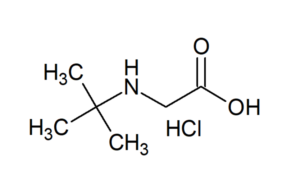
2-(tert-Butylamino)acetic acid hydrochloride (CAS: 6939-23-7) is a chemical compound widely studied and used in research and industrial applications. It belongs to the class of amino acid derivatives and is commonly available in its hydrochloride salt form, which improves stability, solubility, and handling. This compound has gained significance in pharmaceutical research and organic synthesis due to its structural versatility.
Chemical Name: 2-(tert-Butylamino)acetic Acid Hydrochloride
CAS Number: 6939-23-7
Molecular Formula: C6H14ClNO2
Molecular Weight: ~167.63 g/mol
Synonyms: tert-Butylglycine hydrochloride, N-tert-butylglycine HCl
The compound consists of a tert-butylamino group attached to an acetic acid backbone, stabilized as a hydrochloride salt. Key features include:
Appearance: White to off-white crystalline powder
Solubility: Freely soluble in water, slightly soluble in alcohols
Stability: Stable under normal storage conditions (cool, dry, and well-sealed environment)
Used as an intermediate in the synthesis of active pharmaceutical ingredients (APIs).
Plays a role in developing novel therapeutic compounds.
Investigated in drug design studies involving amino acid analogues.
Serves as a building block in peptide synthesis.
Helps in studying structure–activity relationships of amino acid derivatives.
Applied in custom synthesis for producing modified amino acids.
Useful in fine chemical production due to its reactive amino and carboxyl groups.
While 2-(tert-Butylamino)acetic acid hydrochloride is generally stable, standard laboratory safety practices should be followed:
Use protective gloves, goggles, and lab coats.
Avoid inhalation or direct skin/eye contact.
Store in a tightly closed container in a cool and dry place.
Dispose of waste in compliance with local regulations.
2-(tert-Butylamino)acetic acid hydrochloride (CAS: 6939-23-7) is a valuable compound in pharmaceutical, biochemical, and chemical synthesis research. Its stability and functional groups make it an essential intermediate for designing new molecules and exploring biological pathways. With its wide range of applications, this compound continues to play a significant role in advancing chemical and pharmaceutical sciences.